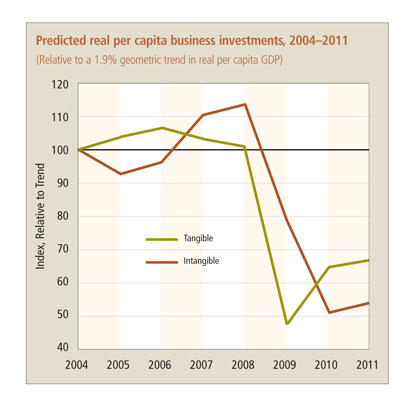For much of the period after World War II, changes in labor productivity were a useful gauge of how well the U.S. economy was faring; workers produced more goods and services per hour during booms than they did during recessions. In fact, economic output and labor productivity—the ratio of gross domestic product to hours worked—often moved in synchrony as the nation’s economic fortunes waxed and waned. But since the mid-1980s the two measures have become less correlated over the business cycle; during the Great Recession, labor productivity increased even as GDP plummeted.

This statistical disconnect has led some researchers to question real business cycle theory—the idea that cyclical fluctuations in the economy are driven in large part by shocks to the productivity of capital and labor. (To be more precise, shocks that are nonmonetary—that is, unrelated to changes in money supply.) If, according to RBC models of aggregate decisions by households and firms, such shocks typically cut output more than hours worked during downturns, how could labor productivity have risen as GDP fell during the last recession?
Recent research by Ellen McGrattan and Edward Prescott, Minneapolis Fed monetary advisers and economists at the University of Minnesota and Arizona State University, respectively, suggests that the divergent paths of GDP and labor productivity during the downturn and at other times in recent decades isn’t as strange as it seems—and that eulogies for existing RBC aggregate theory are premature.
In “The Labor Productivity Puzzle” (Minneapolis Fed Working Paper 694), McGrattan and Prescott find that when established theory includes intangible capital, it accurately predicts the behavior of the actual U.S. economy. Investment in intangible capital is a type of business investment that isn’t counted in the standard measure of labor productivity (GDP divided by hours worked in the market sector).
Quantifying the intangible
Intangible capital consists of assets that can’t be touched and are difficult to measure—spending on things such as research and development, marketing and worker training that add value to a company but are usually reported as expenses rather than as capital investment. As such, most investment in intangible capital is not included in GDP, part of the national accounts kept by the federal government. (For further background on intangible capital, see “The Untouchables” in the December 2005 Region.)
For McGrattan and Prescott, two leading proponents of the use of quantitative, dynamic business cycle modeling to analyze macroeconomic trends, including intangible capital investment in total economic output is the key to making sense of head-scratching countercyclical movements in labor productivity over the past 25 years.
The economists theorized that labor productivity as measured by national accounts might not give a complete picture of the dynamics of production and labor in a cyclical economy. Would productivity trends during the last depressed period look different if intangible investment as well as tangible investments such as new buildings and equipment were counted in official government measures of total economic output? By not including intangible investment in GDP, government figures may underestimate the fall in total, or true, economic output during a downturn—and therefore true labor productivity (total output divided by total hours worked) may decline rather than increase.
“Fewer and fewer people are arguing that [intangible investments] are negligible,” McGrattan said in an interview. “And if intangible investments are declining like tangible investments in a recession, then there really isn’t much of a puzzle in terms of labor productivity movements.”
To test their theory, McGrattan and Prescott developed a model economy in which shocks to the production efficiency of businesses affect the output of goods, services and new intangible capital. A key assumption of the model is that these shocks are “nonneutral”; that is, changes in productivity due to factors such as technological innovation and government regulation affect the creation of new intangible capital differently from the creation of tangible goods and services counted in GDP.
The 2008 financial crisis plays no role in the simulation, because the investigators chose to focus on nonmonetary (or “real”) shocks rather than disruptions that could be attributed to monetary policy, tighter credit or other financial factors that impede investment. “We wanted to see what happens if you don’t have the usual financial factors in there—not one word about banks, the Federal Reserve, the collapse of Lehman Brothers, et cetera,” McGrattan said.
Not so puzzling after all
The economists assumed that shocks in their model were large enough to produce changes in GDP and hours worked comparable with economic data, but didn’t try to match observations on business tangible investment. It turns out that the shocks had a dramatic impact on business investment decisions during the economic downturn; in the model, both tangible and intangible investment fell by about half before starting to recover (see chart).
The sharp drop in intangible investment contributes to a decline in actual economic output greater than that measured by official government GDP accounts. This implies that in the actual U.S. economy, true labor productivity declined significantly during the recent recession—a finding consistent with established aggregate theory based on the neoclassical model of economic growth. Thus, McGrattan and Prescott’s experiment solves the labor productivity puzzle by reconciling the apparent mismatch between theory and economic data that show labor productivity bucking the GDP trend. “The addition of intangible capital and non- neutral technology to the model was crucial in accounting for high productivity and low GDP during the period,” they write.
So in the real economy, did intangible investment fall during the downturn? Economists and statisticians struggle to measure intangible capital directly. But McGrattan and Prescott note that R&D investment and advertising spending—important components of intangible investment—both declined sharply relative to their long-term trends after 2008.
As for evidence of negative shocks curbing capital formation and other economic activity during the downturn, the economists point to costs incurred by businesses to comply with increased federal regulation, including tightened financial rules and environmental standards. Federal regulatory spending and employment increased after 2007, while GDP declined.






